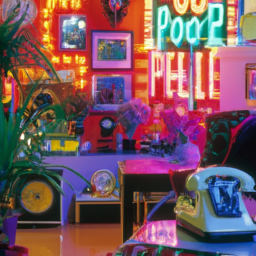Kitsch is a term that has been used to describe a particular artistic style that has been widely consumed and criticized. The term originally comes from German and was used to describe cheap and sentimental objects that were popularized in the mass culture of the 19th century. Kitsch art can be seen as a form of decoration that appeals to the masses, using bright colors, simplified forms, and sentimental themes.
One of the defining characteristics of kitsch art is its lack of aesthetic value, as it often prioritizes sentimentality over authenticity. Kitsch artists tend to use clichéd and formulaic motifs, such as angels, kittens, and rainbows, and rely on exaggerated emotions to elicit a response from the viewer. Kitsch art can also be seen as ironic, as it often imitates high art or historical styles in a simplified and humorous way.
The history of kitsch art can be traced back to the rise of consumerism and the industrialization of culture in the late 19th century. With the advent of mass production and new technologies, objects and images could be easily replicated and distributed to a wider audience. Kitsch art became a way for people to express their individuality and decorate their homes with affordable and accessible objects.
Kitsch art has had a significant impact on popular culture, as it has been used in a variety of media, including film, television, and advertising. Kitsch objects and images have been used to create a sense of nostalgia and to evoke emotional responses from viewers. Kitsch has also been used as a way to critique or parody mainstream culture, as in the case of postmodern art or kitsch revival movements.
Despite its popularity, kitsch art has also been criticized for its lack of authenticity and its association with consumerism and mass culture. Critics argue that kitsch art is a form of cultural pollution that devalues art and aesthetics. They also point out that kitsch art often reinforces stereotypes and reinforces oppressive social norms.
One of the challenges of understanding kitsch art is its subjective nature, as taste and aesthetics can vary widely depending on the viewer. What one person may consider kitsch, another may see as beautiful or meaningful. Kitsch art can also be difficult to define, as it often blurs the lines between high and low culture, art and decoration, and sincerity and irony.
In recent years, there has been a resurgence of interest in kitsch art, as artists and critics have reevaluated its cultural significance and potential for artistic expression. Some artists have embraced kitsch as a way to subvert dominant cultural norms and to create new forms of aesthetic value. Others have used kitsch as a way to explore the tensions between authenticity and artificiality, or to critique consumerism and mass culture.
In conclusion, kitsch art is a complex and multifaceted phenomenon that has been both celebrated and criticized in popular culture. Its history and impact on aesthetics and society are still being explored and debated by artists, critics, and scholars. Understanding kitsch art requires a nuanced and open-minded approach that acknowledges its strengths and weaknesses, its potential and limitations. Whether seen as a form of decoration, irony, or artistic expression, kitsch art remains a fascinating and relevant part of our cultural landscape.
